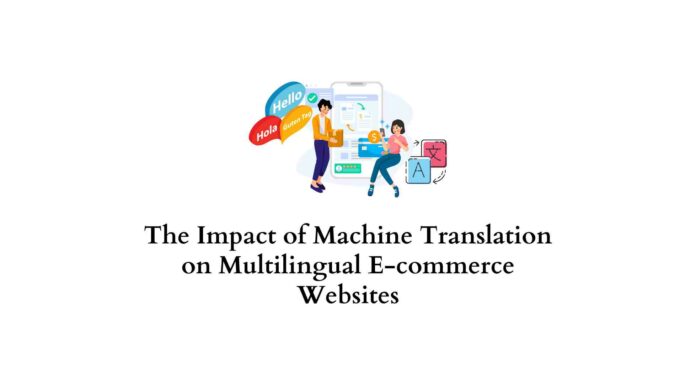Last updated - November 20, 2023
Expand your e-commerce website worldwide and enter new markets. Machine translation is the game-changing technology revolutionizing multilingual e-commerce websites.
In this post, we’ll explore its impact on improving customer experience, increasing user engagement, and optimizing SEO. Join us on this linguistic adventure to make your e-commerce website a global success.
Enhancing Customer Experience Through Machine Translation
The usage of machine translation helps effectively overcome language barriers and create a smooth and engaging e-commerce experience for shoppers. By implementing cutting-edge translation technologies, you can build a closer relationship with consumers and instill trust.
Imagine a Japanese consumer visiting your website and effortlessly navigating product pages in their native language. Familiarity with a product or service can entice people to explore it further and increases the likelihood of nurturing loyal customers who are satisfied with their interactions.
Machine translation allows e-commerce businesses to personalize the shopping experience for customers who speak different languages. By eliminating language barriers, machine translation makes e-commerce more engaging and trustworthy for all visitors.
Improving User Engagement and Conversion Rates
Short attention spans in today’s fast-paced digital environment make it crucial to engage your audience effectively. Machine translation enables communication across languages and creates captivating content that resonates with your target audience.
Developing a deep emotional connection with consumers can be achieved by adjusting product descriptions, blog articles, and marketing materials to align with local language and cultural nuances.
Moreover, well-translated content enhances your credibility by positively impacting conversion rates. A satisfied customer will likely complete their transaction and recommend your website to others.
Optimizing SEO for Multilingual E-commerce Websites
As an e-commerce business owner, you understand the significance of Search Engine Optimization (SEO) in driving organic traffic to your website. It’s essential to realize that SEO involves more than just optimizing keywords on your site.
When expanding your business into new regions, multilingual SEO becomes crucial to improve rankings in international search engines. You can achieve this by adding localized keywords, long-tail phrases, and synonyms with machine translation.
This integration will enhance the visibility of your website, reaching potential buyers in multiple countries and elevating your e-commerce venture to new heights.
Leveraging Machine Translation for Keyword Research
Keyword research is a crucial element of a successful SEO strategy. It involves identifying the search phrases potential clients use to find products similar to yours. Conducting keyword research for multilingual e-commerce presents its challenges.
Thankfully, machine translation offers a solution, allowing you to explore relevant keywords in multiple languages. This powerful tool helps you discover trending keywords, understand customer behavior, and customize your content for different markets. Breaking down language barriers unlocks the boundless potential of global SEO.
Implementing Hreflang Tags for Effective Localization
Hreflang tags are HTML attributes that signal to search engines the language and regional targeting of specific web pages. They send relevant material to the audience.
It is easy to integrate hreflang tags using machine translation. You can accurately assign language codes and region-specific URLs to different iterations of your web pages using automated translation.
As a result, search engines will display the appropriate version of your website to users based on their language and region, boosting user happiness and increasing search engine exposure.
Navigating Cultural Nuances and Localization Challenges
Entering new markets requires a deep understanding of cultural subtleties for success. What may be well-received and appropriate in one culture could be misunderstood or offensive in another.
Using machine translation intelligently helps customize material to cultural sensitivities. Considering the context and emotions underlying the text goes beyond literal translation. As a result, your website will maintain cultural respect and relevancy, fostering powerful interactions with your global clients.
Avoiding Cultural Misunderstandings When Using Machine Translation


Machine translation is effective but has limitations. Cultural terms and idioms can be difficult to translate accurately. Relying solely on machine translation can lead to costly and embarrassing misunderstandings.
Having human translators and editors review the critical text before releasing it will help overcome this. Their experience ensures consistency in your brand message across languages and prevents avoidable mistakes that could damage your image.
Translating Culturally Sensitive Content
Effective translation for e-commerce websites with culturally sensitive items or services requires a careful approach. Combining machine translation with human knowledge is the most suitable method.
Technology can efficiently handle most of the translation process. Human translators ensure the translated text resonates with diverse target audiences by maintaining the original tone and purpose.
Localizing Marketing Materials
Marketing is essential for a successful e-commerce business. Machine translation enables you to adapt your marketing materials for different markets efficiently. Communicating with clients in their local language fosters stronger emotional connections, increasing engagement and conversions.
Choosing the Right Machine Translation Technology
Choosing the right machine translation technology for your e-commerce website can be challenging, given the various options available. Two prominent technologies are rule-based translation and neural network translation. Understanding their differences is crucial for making an informed decision.
Rule-based machine translation relies on predetermined linguistic rules and can be suitable for simple texts. However, it may struggle with complex or context-dependent content. On the other hand, neural machine translation uses artificial intelligence and deep learning to grasp the context better and offer more fluent translations.
Consider your specific content and target languages when deciding on a machine translation technology. Conducting tests on different platforms and gathering customer feedback can also provide valuable insights to help you make the best choice for your business.
Comparing Rule-based and Neural Machine Translation
Rule-based Machine Translation
Linguists create grammatical and syntactical rules for each language pair in rule-based machine translation, which has advanced over the years.
However, this method has limitations. It struggles with context and idiomatic expressions, often leading to overly literal translations that lack natural flow. Maintaining and updating linguistic norms for many languages can be time-consuming and expensive.
On the other hand, rule-based machine translation is valuable for translating technical documents or standardized content that requires precision. Yet, neural machine translation outperforms rule-based approaches for dynamic and context-dependent texts.
Neural Machine Translation


Neural Machine Translation (NMT) is a significant advancement in machine translation technology. Unlike rule-based systems, NMT uses artificial neural networks to process and translate text.
One crucial advantage of NMT is its ability to comprehend context and deliver translations that closely resemble human language. Achieving this involves exposing neural networks to extensive datasets, enabling the system to adapt effectively to various language patterns and idiomatic expressions.
NMT has become the preferred choice for many e-commerce websites due to its capability to handle dynamic, vernacular, and culturally complex text. It consistently provides high-quality translations that cater to the target audience, resulting in a seamless user experience.
Mitigating Potential Risks and Ensuring Quality Control
Machine translation has advantages but also drawbacks, like mistakes and unexpected interpretations. Quality management is crucial for avoiding issues in e-commerce.
One effective strategy is combining machine translation with human editing. This way, the technology provides a translation framework, and human translators can polish the content, ensuring linguistic accuracy and cultural appropriateness.
Creating clear standards and style preferences for translators is essential for maintaining consistency across your multilingual website. Regularly checking translation performance and gathering feedback from users and in-country staff can offer valuable insights for continuous improvement.
Measuring Success and Iterating on Multilingual Strategies
After successfully launching your multilingual e-commerce website, it is essential to constantly assess and continuously improve your translation efforts for long-term success. Evaluate the impact of machine translation on user engagement and conversions using performance measures like website traffic, bounce rates, and conversion rates.
This data analysis will reveal areas needing improvement, enabling you to better cater to your global customer base. Stay mindful that the digital landscape is constantly evolving. To outperform competitors, commit to ongoing improvement and optimization.
Tracking and Analyzing Performance Metrics
Data-driven insights will help you measure your multilingual e-commerce website’s performance effectively. Tracking and analyzing performance metrics are essential to understanding the impact of your translation efforts.
Use analytical tools like Google Analytics or built-in e-commerce platform analytics to gather necessary data on user activity, customer demographics, and engagement patterns across different languages. This information will enable you to make well-informed decisions to enhance your website’s performance and overall consumer experience.
Monitoring User Behavior and Conversion Funnel
Understanding user behavior is essential for data-driven decisions on your multilingual e-commerce website. Analyzing user interactions can help detect friction points and drop-offs in the conversion funnel, leading to improvements in the customer journey.
By examining conversion funnels for different languages, you can identify inconsistencies in user behavior and take corrective measures to boost overall conversion rates.
Gathering Customer Feedback and Local Market Insights


Your consumers are a valuable source of feedback and insights. Actively seeking and listening to their input can provide significant insight into how your multilingual website meets their requirements and expectations.
Use feedback questionnaires, customer surveys, or conduct interviews to understand their experiences. Pay attention to cultural subtleties and preferences indicated in consumer feedback, as they can offer advice for improving your translation efforts and content strategy.
Collaborating with local market specialists or in-country teams can provide vital insights into cultural trends, client preferences, and upcoming market prospects. Combining this insight with machine translation technology can help create a tailored and engaging experience for each audience.
The Key to Success with Multilingual E-commerce
Machine translation can be a powerful tool for e-commerce businesses. Following the tips above, you can use machine translation to make your website content more readable, accurate, and effective. This guide will lead to a better customer experience, increased trust, and higher conversions.











